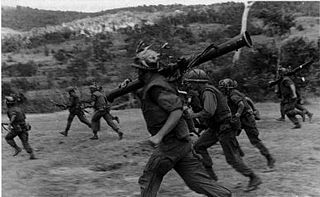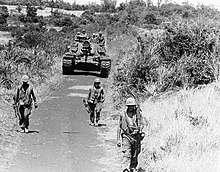
Con Thien was a military base that started out as a U.S. Army Special Forces camp before transitioning to a United States Marine Corps combat base. It was located near the Vietnamese Demilitarized Zone (DMZ) about 3 kilometers (1.9 mi) from North Vietnam in Gio Linh District, Quảng Trị Province. It was the site of fierce fighting from February 1967 through February 1968.

The Hill Fights was a battle during the Vietnam War between the People's Army of Vietnam (PAVN) 325C Division and United States Marines on several hill masses north of the Khe Sanh Combat Base in northwest Quảng Trị Province.

Operation Buffalo was an operation of the Vietnam War that took place in the southern half of the Demilitarized Zone, around Con Thien.

Phase Two of the Tet Offensive of 1968 was launched by the People's Army of Vietnam (PAVN) and Viet Cong (VC) against targets throughout South Vietnam, including Saigon from 29 April to 30 May 1968. The May Offensive was considered much bloodier than the initial phase of the Tet Offensive. U.S. casualties across South Vietnam were 2,169 killed for the entire month of May, making it the deadliest month of the entire Vietnam War for U.S. forces, while South Vietnamese losses were 2,054 killed. PAVN/VC losses exceeded 24,000 killed and over 2,000 captured. The May Offensive was a costly defeat for the PAVN/VC.

Operation Prairie was a U.S. military operation in Quảng Trị Province, South Vietnam that sought to eliminate People's Army of Vietnam (PAVN) forces south of the Demilitarized Zone (DMZ). Over the course of late 1965 and early 1966 the Viet Cong (VC) and the PAVN intensified their military threat along the DMZ. The tactical goal of these incursions was to draw United States military forces away from cities and towns. Operation Hastings, a series of actions in defense of the DMZ, lasted from 15 July to 3 August 1966. It was considered a strategic success. Operation Prairie was conceived as a larger, longer mission covering the same areas along the DMZ.
Operation Prairie IV was an operation conducted by the United States Marine Corps in the area around Con Thien, South Vietnam known as Leatherneck Square from 20 April until 17 May 1967. During the course of the fighting Marine casualties were 164 killed 1,240 wounded while claiming 505 People's Army of Vietnam (PAVN) killed and 9 captured.

Operation Kentucky was a multi-battalion operation conducted by the United States Marine Corps in the area south of the DMZ in Quảng Trị Province. This was another operation to secure the Con Thien area from the People's Army of Vietnam (PAVN). The operation ran from 1 November 1967 until 28 February 1969.

Operation Hickory was a search and destroy operation conducted by the 3rd Marine Division in the area around Con Thien, Quảng Trị Province known as Leatherneck Square from 18 to 28 May 1967. Operation Hickory was the first authorized incursion into the Vietnamese Demilitarized Zone (DMZ).
The 324th Division is an infantry division of the People's Army of Vietnam (PAVN) assigned to the 4th Military Region.

Operation Robin was a U.S. Marine Corps operation that took place southeast of Khe Sanh, Quảng Trị Province from 2–19 June 1968.

Firebase Gio Linh is a former U.S. Marine Corps, U.S. Army and Army of the Republic of Vietnam (ARVN) firebase north of Đông Hà in Quang Tri Province, central Vietnam.
Operation Purple Martin was a US Marine Corps operation that took place in northwest Quảng Trị Province, lasting from 1 March – 2 May 1969.
Operation Virginia Ridge was a US Marine Corps operation that took place in northwest Quảng Trị Province, South Vietnam, from 2 May to 16 July 1969.
Phase III of the Tet offensive of 1968 was launched by the People's Army of Vietnam (PAVN) and Viet Cong (VC) from 17 August to 27 September 1968. The offensive was divided into two waves of attacks from 17 to 31 August 1968 and from 11 to 27 September of that same year.

Operation Napoleon/Saline was a multi-Battalion operation conducted by the United States Marine Corps and the United States Army along the Cửa Việt River south of the DMZ in Quảng Trị Province. The operation ran from 20 January to 9 December 1968.

Operation Lancaster II was a U.S. Marine Corps security operation that took place in northern Quảng Trị Province from 20 January to 23 November 1968 during the Vietnam War. The operation followed on directly from Operation Lancaster. The Marines patrolled aggressively. The response of the People's Army of Vietnam (PAVN) was mixed; Prolonged lulls alternated with fierce fighting. Broadly the Marines felt that they were successful in maintaining the supply route to Ca Lu, at the terminus of Route 9, and in, at least intermittently, disrupting PAVN communications.

Operation Prairie II was a U.S. military operation in Quảng Trị Province, South Vietnam that sought to eliminate People's Army of Vietnam (PAVN) forces south of the Demilitarized Zone (DMZ) that took place from 1 February to 18 March 1967.

Operation Prairie III was a U.S. Marine Corps operation in Quảng Trị Province, South Vietnam that sought to eliminate People's Army of Vietnam (PAVN) forces south of the Demilitarized Zone (DMZ) that took place from 19 March to 19 April 1967.
Firebase O'Reilly is a former Army of the Republic of Vietnam (ARVN) firebase located south of Quảng Trị in Quảng Trị Province, Vietnam.
The DMZ Campaign (1969–71) was a military campaign by the United States Army, United States Marine Corps (USMC) and the Army of the Republic of Vietnam (ARVN) against the People’s Army of Vietnam (PAVN) along the Vietnamese Demilitarized Zone (DMZ) in northern Quảng Trị Province from 1969 to 1971 during the Vietnam War.















